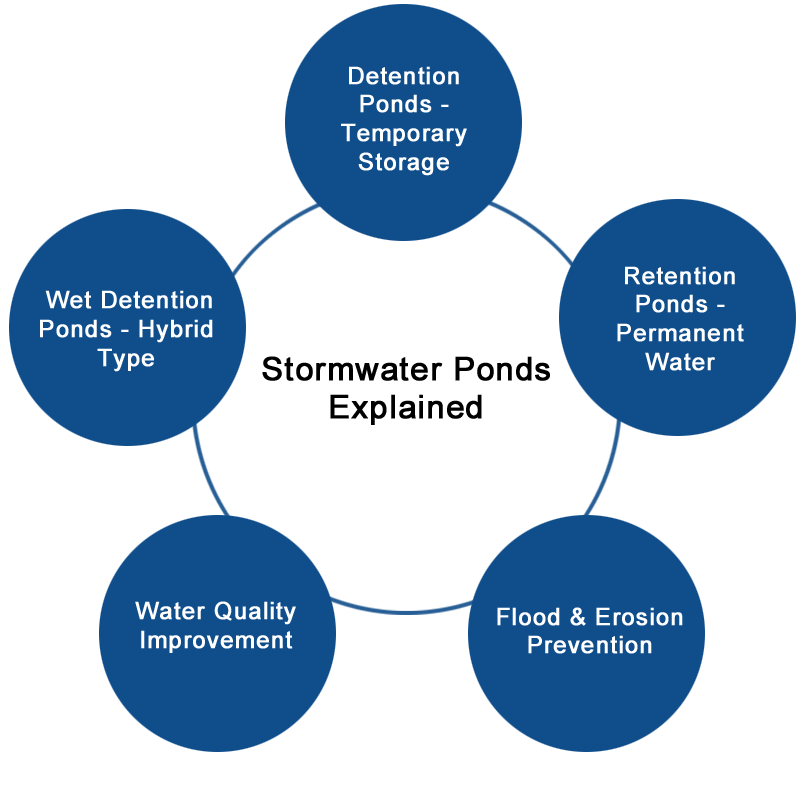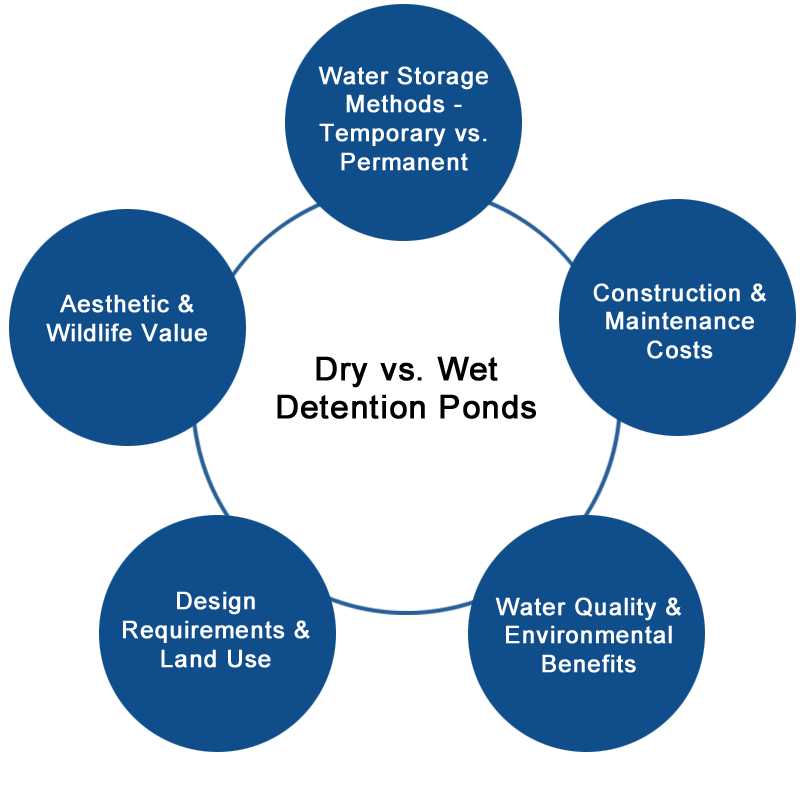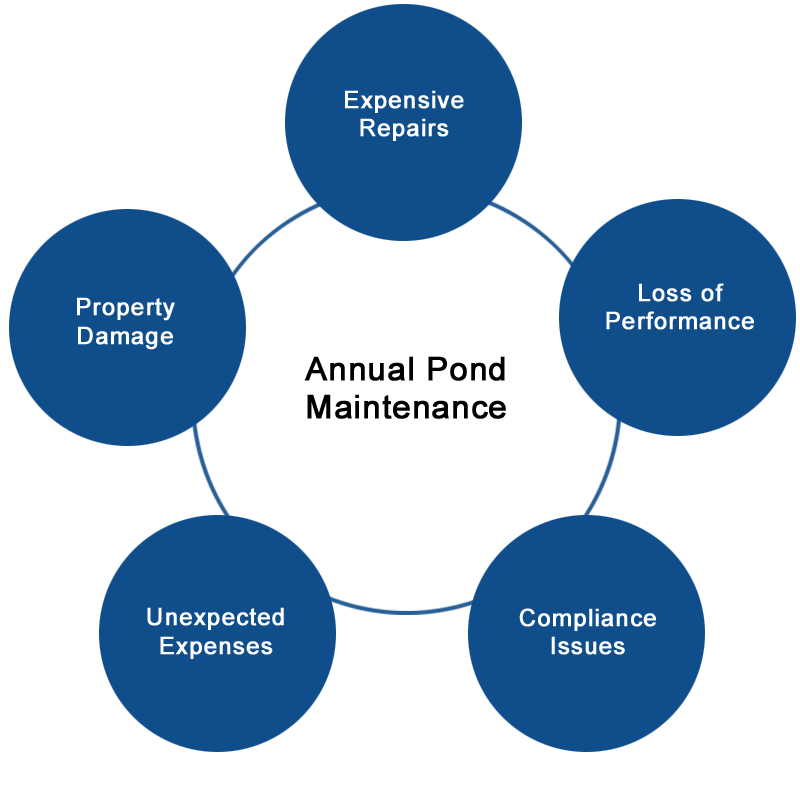Dry and Wet Detention Pond Services
 In the world of water management, there are two types of ponds you may have heard of that each play a vital role in preventing flooding from excessive stormwater during heavy rains. These two types are referred to as “Detention” and “Retention” ponds, and each serves a vital purpose.
In the world of water management, there are two types of ponds you may have heard of that each play a vital role in preventing flooding from excessive stormwater during heavy rains. These two types are referred to as “Detention” and “Retention” ponds, and each serves a vital purpose.
Detention ponds are most importantly built to store water temporarily. A man-made basin, its purpose is to catch excessive stormwater during heavy rains and then hold it there for the hours or days it takes to drain completely, preventing downstream flooding and erosion. As its name suggests, it exists to hold the water in one place, controlling its flow and speed.
Retention ponds are more permanent. While they are built to absorb excessive rainwater during heavy storms, they retain that water year-round, so it never completely drains. These ponds are not only useful for flood control, but they also help improve water quality by allowing pollutants in runoff to settle and be absorbed by plants, rather than letting them wash into waterways.
One type of pond that blurs the distinction between the two is called a “Wet Detention Pond.” Unlike a typical “dry” detention pond, these ponds retain their water long after storms. Unlike a typical retention pond, these ponds were not designed for aesthetic purposes or water quality management. What makes them a form of detention pond is their purpose – wet detention ponds are intended strictly to control stormwater, with any additional water quality benefits being a side effect.
Understanding Dry vs. Wet Detention Ponds
 Under normal conditions, a dry detention pond will simply look like an empty grass bowl. But when stormwater flows in, this dry basin collects the runoff for as long as it’s needed, sometimes up to three days, before the water is slowly released. Generally vented through an outlet structure, the slow release of this water keeps stormwater from building up to flood levels, plus reduces erosion and filters out heavier silt or sand particles. This form of pond can help landowners comply with stormwater management requirements by mitigating damage from floods.
Under normal conditions, a dry detention pond will simply look like an empty grass bowl. But when stormwater flows in, this dry basin collects the runoff for as long as it’s needed, sometimes up to three days, before the water is slowly released. Generally vented through an outlet structure, the slow release of this water keeps stormwater from building up to flood levels, plus reduces erosion and filters out heavier silt or sand particles. This form of pond can help landowners comply with stormwater management requirements by mitigating damage from floods.
While this type of pond may filter out heavier materials, it is not intended to improve the quality of water, merely control its speed and the amount flowing down. Because they are simpler in structure, they are typically less expensive than wet ponds and need only regular sediment removal, erosion repair and outlet inspection to maintain. If not maintained properly, their capacity will be reduced over time. There are other drawbacks to a dry pond – they require much more land, are less aesthetically pleasing than a landscaped pond, and if they are not maintained, they can lead to standing water and mosquito growth.
A wet detention pond, which may also be called a retention basin or wet pond, looks and functions more like a permanent pond would. Maintaining a certain level of water throughout the year, they expand as rainwater pours in, letting it mix with the existing water, then slowly releasing it. This helps temporarily store and release flood waters at a controlled rate, like a dry pond, while also significantly improving water quality by absorbing pollutants and nutrients.
While they are typically more expensive to build and require greater upkeep in the form of removing sediment, managing vegetation, and controlling water level, they offer many environmental benefits and can serve as a habitat for fish, birds, and other wildlife while keeping landscaping attractive.
Either form is designed to slow the flow of rainwater and protect areas downstream from flooding or erosion during storms. A dry detention pond will cost less, but won’t significantly control water quality. A wet detention pond will cost more, but add environmental and aesthetic value.
At Estate Management Services, we design, build, and maintain a variety of different types of detention ponds for clients from private homeowners to municipalities. Our experts can handle any stage of the process, whether it’s excavating and grading to put a pond on bare land or maintaining an existing stormwater mitigation system through structural repairs, inspections, debris removal, erosion control, performance testing, and vegetation management. That expertise gives you the peace of mind that your pond is functioning properly, operating at peak efficiency, and meeting all regulations.
How An Annual Stormwater Maintenance Plan Can Save Your Detention Pond
 Our robust package of options for your pond ensures that everything functions smoothly as it should. With regular maintenance from the experts at Estate Management Services, you can avoid:
Our robust package of options for your pond ensures that everything functions smoothly as it should. With regular maintenance from the experts at Estate Management Services, you can avoid:
Expensive Repairs: Unless a pond is properly maintained, small issues can become costly problems. Clogged inlets, excessive sediment, and erosion are easy to control with regular inspections and maintenance, letting you stop them before they become major issues.
Loss of Performance: Your pond has an ideal capacity and rate at which stormwater flows through it, either of which can deteriorate as debris, sediment, and vegetation build up. Regular maintenance, including clearing inlet and outlet structures, can restore the pond’s full capacity and allow it to operate at peak performance.
Compliance Issues: In many municipalities, a strict set of inspection and maintenance standards is required for each pond. Our services meet and exceed these standards, with detailed documentation of every service performed to ensure inspections are easily passed, helping you avoid fines.
Unexpected Expenses: Our annual maintenance plans allow for predictable costs of ownership for your pond while avoiding the expense of unforeseen emergency repairs. This lets you eliminate surprises and stick to your budget with confidence.
Property Damage: Your pond’s purpose is to keep excessive rainwater from damaging surrounding property downstream and causing environmental pollution. By ensuring regular maintenance, you can rest easy knowing that it has been maintained to safeguard your property.
We offer these maintenance plans along with new construction services to a variety of clients, including HOAs, POAs, golf courses, private homeowners, property management firms, commercial and industrial facilities, engineering and development firms, apartment complexes, hotels and resorts, plus cities and municipalities, big and small.
From building a pond to giving it the service that allows it to operate at peak performance for years to come, our tailored solutions keep your stormwater system running efficiently, maintain regulatory compliance, and protect your property. Call us today for a free, no-obligation property inspection by submitting your contact information below.
